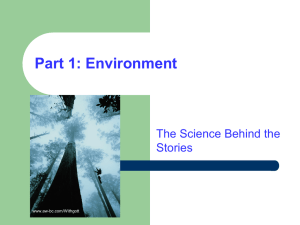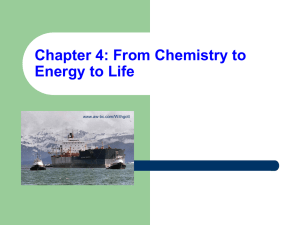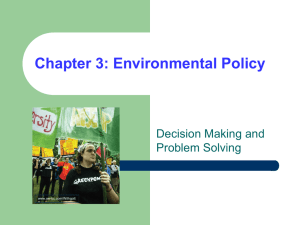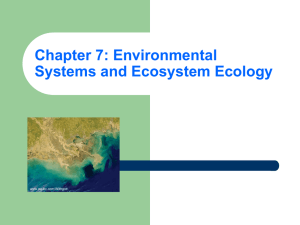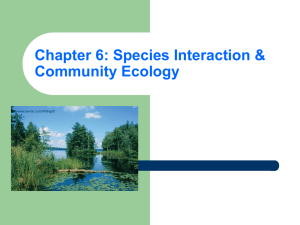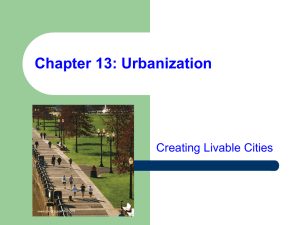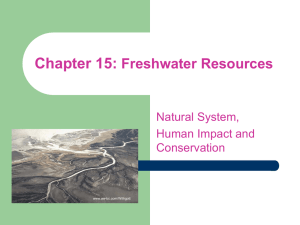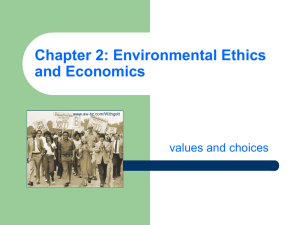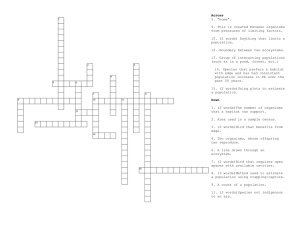Chapter 5: Evolution, Biodiversity & Population Ecology www.aw-bc.com/Withgott
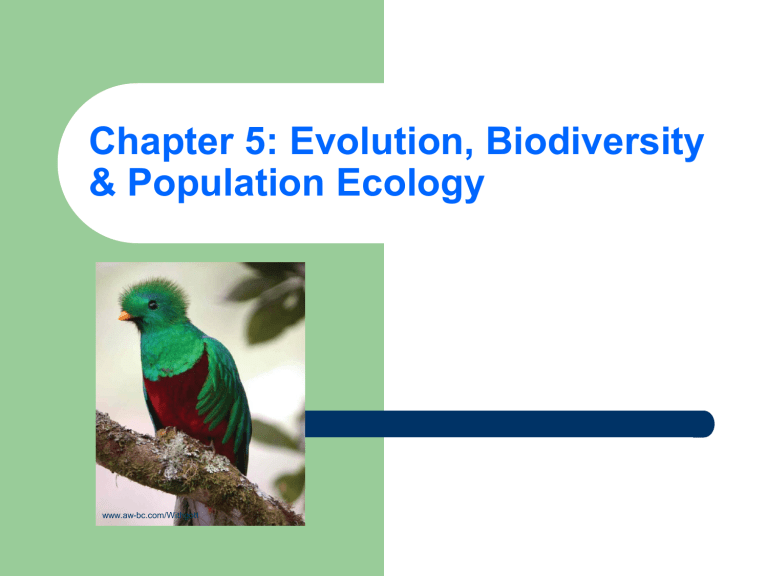
Chapter 5: Evolution, Biodiversity
& Population Ecology www.aw-bc.com/Withgott
Evolution
genetic change in populations of organisms across generations.
modifications
– appearance: www.aw-bc.com/Withgott
Evolution
– functioning: beaks in honeycreepers www.aw-bc.com/Withgott
Natural Selection
explains the great variety of living organisms.
derives from several premises noticed in nature
Natural Selection Premises
constant struggle of organisms to survive and mate
organisms tend to produce more offspring that can survive.
individuals of the same species are not identical
– variation
Variation
genetical differences
environment within which genes are expressed
interaction between genes and environment
Adaptation : trait that promotes success of a species
Effects of Natural Selection on Genetic
Variation
Mutations : accidental changes in the nucleotide sequence of the DNA
addition
deletion
substitution
Sexual Reproduction also Generates
Variation
recombination of genes produces a novel combination generating variation
– directional selection
– stabilizing selection
– disruptive selection
Directional selection
selection that drives a feature in one direction www.aw-bc.com/Withgott
Stabilizing selection
preserves status quo, no changes www.aw-bc.com/Withgott
Disruptive Selection
traits diverge into two or more directions www.aw-bc.com/Withgott
Evidence of Natural Selection
Selective breeding
breeding of domesticated animals and plants
– dog and cat breeds
– variations of Brassica oleracea
– artificial selection
Biodiversity
Total of all organisms in the area
–
–
–
– diversity of species gene pool populations communities
Evolution generates biological diversity
– as of 2008 1:3 amphibians, 1:7 birds and 1:5 mammals is considered endangered or threaten (National Geographic)
Species: organism that is able to reproduce and have viable offspring
Speciation: Allopatric & Sympatric
Allopatric : species form due to physical separation
mutations can occur independently
members of different populations don't mate
populations continue diverging through time
single species can generate multiple species through time
Separation of Populations
glacial ice sheets during ice ages change of course of major rivers rise of mountain ranges evaporation of major lakes into smaller bodies of water temperature variation causing migration of plant populations creating new patterns of animal/plant distribution isolation must remain for thousands of generations reunion of populations may occur, but if they are not able to interbreed, two or more new species have emerged.
Sympatric
reproductively isolated due to behavioral causes
feeding at different times of the day
feed at different sites
mating on different times of the year
hybridization in some plants
mutations causing change in number of chromosomes
Diversification
as a result of numerous speciation events
phylogenetic trees explain differences and similarities between species
Speciation and extinction
natural process that takes 1-10 million years
Diversification www.aw-bc.com/Withgott
Species Vulnerable to Extinction
some species may be more vulnerable than others due to change in environmental conditions
–
–
–
– climate change rise and fall of sea level arrival of harmful species extreme weather events (drought, flood, etc.)
Endemic : single small population present only in a particular type of environment: Attwater chicken
Attwater Chicken
1 million individuals in 1900
50 or so individuals today habitat disruption
– oil industry, housing, cattle, rice fields predators (snake, rat, skunk) diseases weather collision (fence, cars) fire ants (kill chicks)
Levels of Ecological Organization
Species
Population
Communities
Ecosystems
Biosphere
www.aw-bc.com/Withgott
Ecological Organization
Habitat, Niche and Specialization
Habitat: living and non-living elements around a species
–
– thriving of a species depends on patterns of habitat use each species' habitat is scale dependent
–
– habitat selection is possible if the species is mobile the survival of the species depends if the habitat is suitable or not
Niche
a species' niche reflects its use of resources and functional role in the ecosystem
"job" specialists and generalists
– Prairie dog
eats grasses and keeps grass low for predator control more grass grown around burrow because
–
– airiates soil by digging soil becomes richer near burrows because of dung burrow houses other animals when empty (snakes, rabbits, owls)
Population Ecology
Population size : number of individuals present at a given time
– Attwater chicken- 1 million to 50 individuals
Population density : number of individuals per population per unit area
– golden toad- large population in a small area
Population distribution : spatial arrangement of organisms within an area. There are 3 types.
Population Distribution: Random www.aw-bc.com/Withgott
Uniform www.aw-bc.com/Withgott
Clumped www.aw-bc.com/Withgott
Population Ecology
sex ratio : depends on the behavior (monogamous or polygamous) of the species, type of reproduction
(autofecundates or different sexes) age structure : age structure diagrams www.aw-bc.com/Withgott
Population Ecology
birth and death rates : survivorship curves
– type I: higher mortality at older age
–
– type II: equal rate of death at any age type III: higher rate of death at younger age www.aw-bc.com/Withgott k-selected r-selected
Population Ecology
Immigration emigration growth rate
Unregulated population increase : shows exponential growth= J curve
–
– carrying capacity causes logistic growth curve (S curve) to show caused by an environmental resistance (water, food, shelter, predators, disease)
Density-dependent factors
its influence is affected by the population density
– competition
food
shelter
mate
water
s-shaped curve
Density-independent factors
influence is not affected by population density; can eliminate large numbers of individuals without regard to its density
extreme temperatures
catastrophic climate events
fires
volcano eruptions
Biotic Potential vs Reproductive
Strategy
k-selected (k stands for Carrying capacity)
low biotic potential
long gestation period
protects offspring as an investment for species survivor
relative few offspring during lifetime
type 1 curve
– eg: humans, whale, rhino, elephant
r-selected (r stands for rate)
focus on quantity not quality
– high biotic potential
– large number of offspring
– survivor of offspring depends on chance
– type 3 curve
– eg. fish, frogs, snails
Conservation of Biodiversity
social and economic factors
– human behavior towards environment
– economy vs environmental protection
protection of environment
– began without much government support
– even today governments may not have the funds
– ecotourism is the key
THE END
